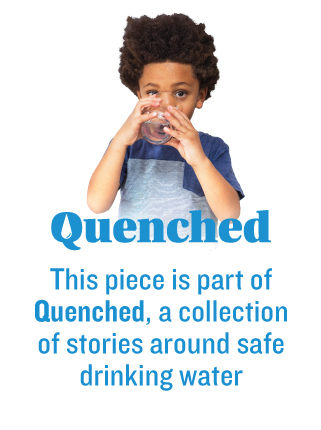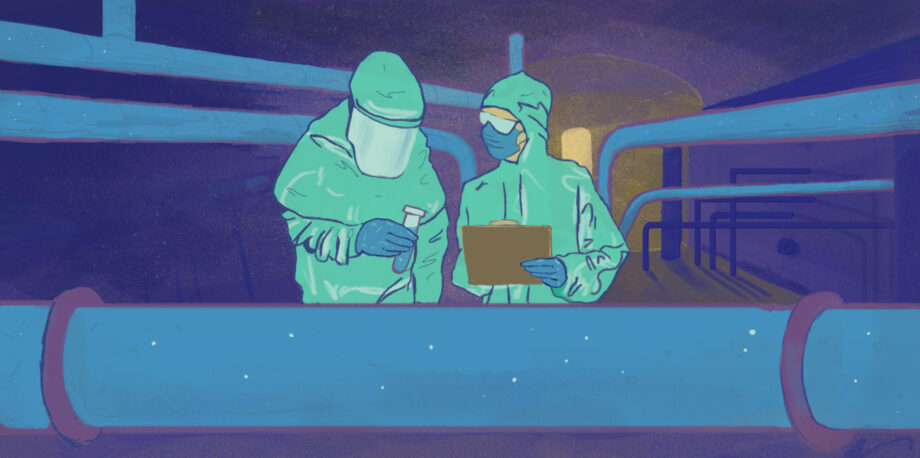April 23, 2020 —  Many hard lessons have already been learned — and, in some cases, ignored — as the COVID-19 pandemic ravages the world. The good news is that, so far, the water and wastewater sectors in the United States have been largely spared. This likely will continue to be the case: Treated drinking water will remain safe to drink, and utility and wastewater treatment workers do not appear to be in any novel danger.
Many hard lessons have already been learned — and, in some cases, ignored — as the COVID-19 pandemic ravages the world. The good news is that, so far, the water and wastewater sectors in the United States have been largely spared. This likely will continue to be the case: Treated drinking water will remain safe to drink, and utility and wastewater treatment workers do not appear to be in any novel danger.
Our job now is to do everything we can to keep this infrastructure and the approximate 102,000 treatment plant workers in this country that sustain it safe. For the sake of public health, as well as the environment, we cannot afford to be caught off guard. The health-care system worldwide has been pushed to the brink of collapse by this pandemic, and we cannot add to that misery by having water and wastewater utilities hobbled as well.
What We Know
Modern water treatment plants are already equipped to remove pathogens, including viruses, through filtration and disinfection. Recent testing by numerous water districts around the country, including those in my area served by the Metropolitan Water District of Southern California, have found no presence of the novel coronavirus in treated water samples.
Wastewater is much the same when it comes to coronaviruses. The new coronavirus has been found in human waste. But the standard disinfection methods, such as oxidation with hypochlorite and peracetic acid, as well as inactivation through the use of ultraviolet irradiation, work. That said, it should be noted that previous coronaviruses have been able to remain in untreated wastewater for up to several days.
What We Don’t Know
The novel coronavirus is just that — novel. According to environmental researchers at the University of Arizona, “transmission of coronaviruses tend[s] to be limited in the aqueous environment due to the fact that they are rapidly inactivated in water and wastewater at ambient temperatures.” But we need to keep an eye on the novel coronavirus to see if it behaves similarly to the other six known coronaviruses. If the new virus does not become inactive within two or three days in wastewater, as do the other coronaviruses, then more aggressive containment or disinfection measures would need to be considered.
What We Need to Do
Water managers should take a number of actions in the meantime to keep our water supplies safe in the face of this viral threat. These include:
Conduct wastewater-based epidemiology. Recent studies have shown that the virus causing COVID-19 can be found in the feces and urine of infected people and can survive for up to several days after exiting the human body. Research teams have been working on new tests to detect the novel coronavirus in the wastewater of communities infected with the virus. The idea is to provide an effective and rapid way to predict the potential spread of COVID-19 by picking up on biomarkers in feces and urine from disease carriers that enter the sewer system. Test kits could be sent to participating wastewater facilities to collect 24-hour composite samples for processing. The data from these samples would map COVID-19 across the country effectively measuring the scope of the outbreak. Due to the limitation of patient testing, this could be an efficient way to track the spread of COVID-19.
By the same token, it’s important to monitor sanitary sewer overflows (SSOs) — releases of untreated sewage into the environment — and combined sewer overflows (CSOs) — releases of stormwater that contains untreated or partially treated human and other waste. Monitoring these could become especially crucial in areas where large numbers of infections are known to have taken place, for example, near hospitals treating COVID-19 patients.
Reduce exposure to aerosols. We need to ensure that we limit exposure to pathogens that might become aerosolized — that is, spread in tiny particles smaller than the droplets released during sneezing or coughing — in open ponds at wastewater treatment plants, or in hospitals or residential buildings with faulty plumbing, as happened in Hong Kong in 2003. It’s important to take extra precautions when external conditions influence the survival or exposure of the novel coronavirus, such as humidity, temperature and wind. Likewise, it’s important to reinforce the proper use of personal protective equipment (PPE) during wastewater treatment procedures such as cleaning filters. Furthermore, highly turbulent open conduits and mixing chambers should be covered or shielded to prevent the release of aerosols into the atmosphere.
Stockpile essential equipment. As we have already seen, the just-in-time method of product distribution that became vogue in recent years is ill-suited for pandemics. We must ensure that each water treatment and wastewater facility has a reasonable stockpile of chemicals and filter media as well as proper PPE on site to contend with potential shortages and scarcity.
Increase automation. We need to further automate water and wastewater facilities to minimize operator involvement. Water treatment plants should use air burst or some other form of dislodging larger materials in place of manual screen cleaning. And wherever possible, water and wastewater treatment plants should provide online instrumentation for processes such as checking turbidity or chlorine levels. This will minimize the need for manual sampling and so reduce the possibility that plant operators could expose themselves to contamination.
Fine-tune equipment and procedures. Other things water treatment plant operatorscan do to reduce exposure to untreated water include tightening packing glands on pumps; using access doors, rather than grates, on mixing chambers and flocculators; properly draining water to floor drains; and providing water level–monitoring equipment that avoids the need to use tape measures or dipsticks. Operators also should check chemical feed systems for leaks; replace older pumps with newer models that allow for remote control and flow pacing; and use flow meters to measurement chemicals.
Improve communication. We need to reinforce the messages we send to water utility employees to use proper PPE on the job and to stay home when they’re sick. There have been anecdotal reports of utility workers becoming infected off the job and then bringing their illness to the treatment plant. I doubt this is widespread, but we cannot afford to have these essential workers out sick.
Providing the public with critical information — particularly about the health and safety of our water supplies and infrastructure — is also paramount for water utilities. And we must vow not to shut off service to our customers but rather work with them to resolve delayed or missed payments, because studies have shown that discontinued water service increases the rates of infectious diseases within communities.
This is truly an unprecedented time in our modern history, but we will get through it as our human race has many times before. And, like those previous times, we will adapt and emerge stronger and smarter.
Editor’s note: The views expressed here are those of the author and not necessarily of Ensia. We present them to further discussion around important topics. We encourage you to respond with a comment below, following our commenting guidelines, which can be found on this page. In addition, you might consider submitting a Voices piece of your own. See Ensia’s Contact page for submission guidelines.
Related Posts
Ensia shares solutions-focused stories free of charge through our online magazine and partner media. That means audiences around the world have ready access to stories that can — and do — help them shape a better future. If you value our work, please show your support today.
Yes, I'll support Ensia!





My name is Rickey Peters. I am saddened to see the devastating impact of COVID-19 in our nation and across the world; my prayers are with us all. I worked for thirty years as a plant operator for Kansas City, MO. Water Department, Wastewater Treatment Division. While working, I advanced to an “A” level wastewater treatment certification. I retired thirteen years ago. Attached is my poem, “The Wastewater Treatment Plant Workers’ Higher Calling.” The purpose of writing my poetry is my way of giving back to the water treatment profession. I hope to highlight the enormous service and sacrifice the water treatment industry provides for humanity. The U.S. Department of Homeland Security has identified the men and women operating our WWTPs as essential and critical to our everyday living. My poetry has stepped into our moment of COVID-19 crisis and offer words of encouragement to the WWTP workers. Those brave men and women are on the front-line amidst an empire of diseases performing their duties to save our waterways.
Stay safe and healthy,
Rickey L. Peters
The Wastewater Treatment Plant Workers’ Higher Calling
Around the kingly and regal conference table sat the Chairman and the Board. Staff members were presenting their year-end reports. The chief of staff, Gabriel, stood and reported, "Mr. Chairman the human race is polluting the waters so much that the natural purification cycle cannot keep up. If the pollution continues at this rate, all of mankind and the poor innocent creatures on earth will soon be poisoned by the contaminated waters."
Gabriel continued, “It is a sad indictment against mankind that these waters that were once clean and clear have now become filthy and foul. The waters that were once bubbling, sparkling, rippling and flowing have now become a nasty, stagnant, foul-smelling cesspool of man's waste." Gabriel requested, "Mr. Chairman may I blow my horn which will be a signal to our managers to immediately evict all these people who have served as horrible stewards?"
The Chairman of the Board rose from His throne-like chair and said, "I understand what you are saying Gabriel, but I am going to give them a little more time on their lease. You see I have a plan to produce wastewater treatment plants to aid in nature’s purification process. The designers and builders of these plants will occupy the scene for a while. Nonetheless, the wastewater treatment plant workers will be there from now on and their responsibility will be to maintain and efficiently operate the wastewater treatment plant.” So it became a higher calling: the wastewater treatment plant workers’ marching orders are to reclaim the waters by recycling, replenishing and reviving the polluted waters.
© 2019 Rickey L. Peters